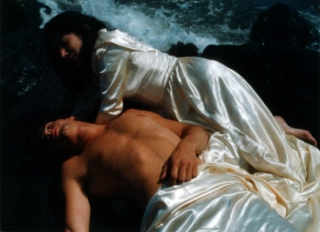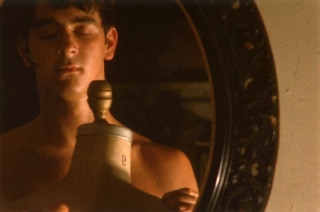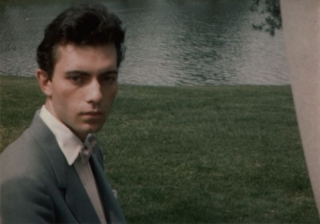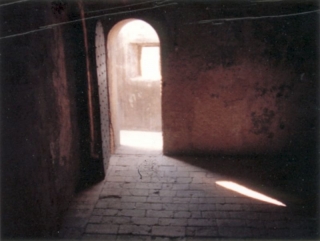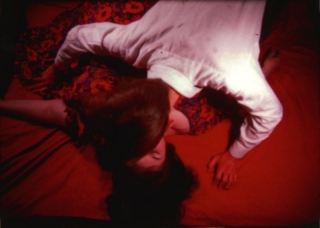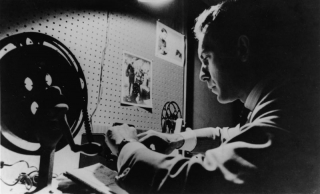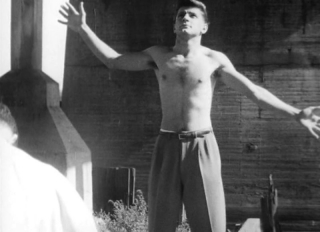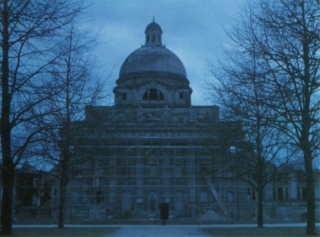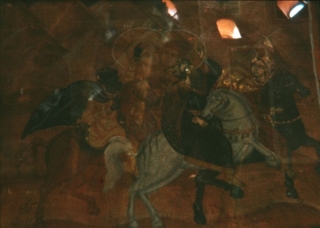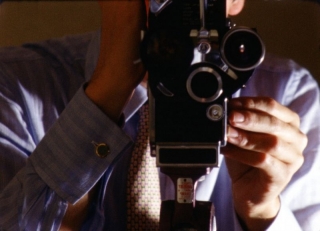Date: 28 March 2009 | Season: Gregory Markopoulos 2009 | Tags: Gregory Markopoulos, London Lesbian & Gay Film Festival
GREGORY J. MARKOPOULOS
London Lesbian & Gay Film Festival 2009
Saturday 28 March 2009, at 4:30pm
London BFI Southbank NFT3
TWICE A MAN
Gregory J. Markopoulos, USA, 1963, 16mm, colour, sound, 49 min
with Paul Kilb, Olympia Dukakis, Albert Torgesen
Twice A Man is a fragmented re-imagining of the Greek myth of Hippolytus, who was killed after rejecting the advances of his stepmother. Markopoulos’ vision transposes the legend to 1960s New York and has its main character abandon his mother for an elder man. Employing sensuous use of colour, the film radicalised narrative construction with its mosaic of ‘thought images’ that shift tenses and compress time. One of the touchstones of independent filmmaking, Twice A Man was made in the same remarkable milieu as Scorpio Rising and Flaming Creatures by a filmmaker named ‘the American avant-garde cinema’s supreme erotic poet’ by its key critic P. Adams Sitney.
MING GREEN
Gregory J. Markopoulos, USA, 1966, 16mm, colour, sound, 7 min
An extraordinary self-portrait conveyed through the multiple layered superimpositions of the filmmaker’s sparsely furnished room.
Date: 30 March 2009 | Season: Gregory Markopoulos 2009 | Tags: Gregory Markopoulos, London Lesbian & Gay Film Festival
GREGORY J. MARKOPOULOS
London Lesbian & Gay Film Festival 2009
Monday 28 March 2009, at 8:45pm
London BFI Southbank NFT3
EROS, O BASILEUS
Gregory J. Markopoulos, USA, 1967, 16mm, colour, sound, 45 min
with Robert Beavers
Markopoulos’ invocation of Eros merges classical and contemporary imagery by placing the male god of love in an artists’ loft. The sole protagonist, predominantly naked, appears in a series of tableaux surrounded by icons of creativity, including paintings, books and filmmaking equipment. This sculptural study of the human form is energised by flash frames, stylised fades, and Strauss’ tone-poem ‘Ein Heldenleben’. Eros is portrayed by the young filmmaker Robert Beavers, who had recently moved to New York after seeing films by Markopoulos and other New American Cinema pioneers. Both soon left America for Europe, where they remained together until Markopoulos’ death in 1992.
THROUGH A LENS BRIGHTLY: MARK TURBYFILL
Gregory J. Markopoulos, USA, 1967, 16mm, colour, sound, 15 min
The life of painter, dancer and poet Mark Turbyfill, seen in his 70th year, is evoked through traditional portraiture and personal objects.
Date: 14 March 2011 | Season: Miscellaneous | Tags: Gregory Markopoulos
IN FOCUS: GREGORY MARKOPOULOS
Tuesday 8 March 2011, at 7pm
Gent Cinema OFFoff
Gregory J. Markopoulos (1928-1992) groeide op in Toledo, Ohio, als kind van Griekse immigranten, maar keerde terug naar Griekenland in 1967. Na twintig jaar films maken in de Verenigde Staten besloot hij vanuit zijn idealistische visie op de artistieke en professionele onafhankelijkheid van de filmmaker en het kunstencircuit om zijn films samen te brengen in het Temenos Film Project. Daarin volgde hij zijn eigen koers in de ontsluiting van zijn oeuvre samen met zijn partner, de filmmaker Robert Beavers. OFFoff vertoont tijdens de maand maart drie programma’s gecompileerd door Temenos. Het eerste luik bevat de volgende kortfilms: Swain(1950), die eerst de titel Rain Black My Love droeg en waarin de regisseur zelf de protagonist is, Flowers of Asphalt (1951) die footage bevat uit iets vroeger werk, met name Jackdaw (1950) en Christmas USA (1949), de stille film Eldora (1953) en tot slot het beroemde Twice A Man (1963). Deze sensuele film, met muziek van Tchaikovsky, is gebaseerd op de mythe van de aseksuele Hippolytos, die ten val kwam met zijn paard door de grillen van jaloerse goden. Markopoulos beoogde een uitgepuurd evenwicht tussen narratie, montage, mise-en-scène, en geluid. Zijn consequente esthetisme en de psychodramatische geladenheid van zijn films maken dat hij een unieke status bekleedt binnen de geschiedenis van de Amerikaanse avant-garde.
Gregory Markopoulos, Swain, USA, 1950, 16mm, colour, sound, 24 min
Gregory Markopoulos, Flowers of Asphalt, USA, 1951, 16mm, b/w, silent, 7 min
Gregory Markopoulos, Eldora, USA, 1953, 16mm, colour, silent, 8 min
Gregory Markopoulos, Twice a Man, USA, 1963, 16mm, colour, sound, 48 min
Deze screening wordt ingeleid door onafhankelijk filmcurator Mark Webber. Webber presenteert het oeuvre van Markopoulos wereldwijd. Op dit moment voltooit hij zijn boek Film as Film: The Collected Writings of Gregory J. Markopoulos dat volgend jaar zal verschijnen. Hij nam het curatorschap op zich van screenings en tentoonstellingen van onder meer Andy Warhol, Robert Beavers, Owen Land en de London Filmmakers Co-op en was gastcurator voor het BFI London Film Festival.
Met dank aan Robert Beavers (Temenos).
Date: 5 October 2011 | Season: Miscellaneous | Tags: Gregory Markopoulos
IN FOCUS: GREGORY MARKOPOULOS
Wednesday 5 October 2011, at 7pm
Paris Centre Pompidou
Markopoulos’ portrait of the castle of Rocca Sinibalda (then owned by patron, publisher and activist Caresse Crosby) employs a complex system of fades to extend five minutes of footage to an hour of viewing time. The film, in which brief images appear amongst measures of black and clear frames, was a crucial step in an innovation of film form that culminated in the monumental ENIAIOS cycle (1948-90).
Gregory J. Markopoulos, Gammelion, USA, 1968, 16mm, colour, sound, 55 minutes.
Dedicated to Gregg Sharits. Music by Albert Roussel: excerpt from “Serenade”. Text excerpt from Rainer Maria Rilke’s “The Notebooks of Malte Laurids Brigge”, read by Gregory Markopoulos. Filmed at Il Castello Roccasinibalda, Rieti, Italy.
The screening will be introduced by Mark Webber, an independent curator and editor of Film as Film: The Collected Writings of Gregory J. Markopoulos.
Date: 2 August 2014 | Season: Gregory Markopoulos: Film as Film | Tags: Gregory Markopoulos
THE ILLIAC PASSION
Saturday 2 August 2014, at 2pm
Guanajuato Teatro Juarez
Gregory J. Markopoulos (1928-92) was one of the most original filmmakers to emerge from the post-war avant-garde. His films, which often translated literary or mythological sources to a contemporary context, are celebrated for their extraordinary creativity, the sensuous use of colour and innovations in cinematic form. In the 1960s, Markopoulos was actively involved in New York’s vibrant film community – the same milieu in which landmark works such as Scorpio Rising (Kenneth Anger), Flaming Creatures (Jack Smith) and The Chelsea Girls (Andy Warhol) first enraptured audiences. It was here that Markopoulos made one of his most celebrated films, The Illiac Passion, an extravagant interpretation of ‘Prometheus Bound’ populated with fantastic characters from the underground scene. Warhol appears as Poseidon, alongside Beverly Grant, Taylor Mead, Jack Smith, and other important figures. The soundtrack of this visionary re-imagining of the classical realm features a fractured reading of Thoreau’s translation of Aeschylus and excerpts from Bartók.
Gregory J. Markopoulos, The Illiac Passion, 1964-67, 92 min
This rare screening of The Illiac Passion celebrates the publication of Film as Film: The Collected Writings of Gregory J. Markopoulos (The Visible Press, 2014) and will be introduced by the book’s editor Mark Webber.
Also screening: 5 August 2014 at Mexico City Centro de Cultura Digital
PROGRAMME NOTES
THE ILLIAC PASSION
Saturday 2 August 2014, at 2pm
Guanajuato Teatro Juarez
THE ILLIAC PASSION
Gregory J. Markopoulos, USA, 1964-67, 16mm, sound, colour, 92 minutes
Inspired by Aeschylus’ Prometheus Bound. Music by Béla Bartok (excerpt from Cantata Profana). Voiceover by Gregory Markopoulos, reading from the American translation of Prometheus Bound by Henry David Thoreau. Costumes by Jerome Hiler.
Cast: Richard Beauvais (Prometheus), David Beauvais (his conscience), Robert Alvarez (Narcissus), Taylor Mead (the Demon or Sprite), Sheila Gary (Echo), Peggy Murray (the Muse), Tom Venturi (Hyacinthus), Tally Brown (Venus), Kenneth King (Adonis), gerard Malanga (Ganymede), Jack Smith (Orpheus), Jan Chipman (Eurydice), Andy Warhol (Poseidon), Phillip Klass (Daedelus), Margot Brier (Pandora), Paul Swan (Zeus), Wayne Weber (Icarus), Carlos Anduze (Hades), Stella Dundas (Moon Goddess), John Dowd (Endymion), Philip Marker (Apollo), Beverly Grant (Persephone / Demeter), Clara Hoover (Io), Gregory Battcock (Phaeton), and Gregory Markopoulos (as himself).
Back to top
Date: 8 September 2014 | Season: Gregory Markopoulos: Film as Film | Tags: Gregory Markopoulos
GREGORY J. MARKOPOULOS: FILM AS FILM
8—13 September 2014
New York Anthology Film Archives
“There is no language. There is no art. There is no knowledge. There is but film as film: the beginning and the eternal moment.” (The Intuition Space, 1973)
Gregory J. Markopoulos (1928-92) is one of the most original filmmakers to emerge from the post-war avant-garde. His films, which often translated literary or mythological sources to a contemporary context, are celebrated for their extraordinary creativity, the sensuous use of color and innovations in cinematic form. A co-founder of the New American Cinema Group, Markopoulos was actively involved in nurturing New York’s film community before moving to Europe at the end of the 1960s to pursue a more individual path. Firmly believing that a filmmaker should be responsibility for all aspects of his work, he developed the idea of Temenos, a monographic archive for the preservation, presentation and study of his films.
In parallel to his filmmaking, Markopoulos was a prolific writer whose articles were circulated in journals, self-published editions or program notes. This screening series celebrates the publication of Film as Film: The Collected Writings of Gregory J. Markopoulos, a new book that gathers together some ninety out-of-print or previously unavailable texts by the filmmaker. See www.thevisiblepress.com for more information on the book, and for details of additional events at Light Industry, The Kitchen, Harvard Film Archive and elsewhere this fall.
This is an extremely rare opportunity to see Markopoulos’ earliest works, shown alongside some of the first films made in Europe following his departure from the US in 1967. Robert Beavers and Mark Webber (the editor of “Film as Film”) will be present and the book will be available for purchase at the programmes.
Date: 8 September 2014 | Season: Gregory Markopoulos: Film as Film | Tags: Gregory Markopoulos
GREGORY J. MARKOPOULOS: FILM AS FILM 1
Monday 8 September 2014, at 7:30pm
New York Anthology Film Archives
Made as a USC student in Los Angeles, Markopoulos’ first 16mm film Psyche took as its source the unfinished novella of the same name by Pierre Louÿs. Shown together with Lysis and Charmides (both made on his return to Toledo, Ohio, and inspired by Platonic dialogues), it forms the trilogy titled Du sang de la volupte et de la mort (1947-48). By boldly addressing lesbian and homosexual themes, the trilogy gained unwelcome notices in Films in Review and Variety where, in the repressive atmosphere of the early 1950s, it was branded “degenerate” following a screening at NYU. Such a response is unimaginable today for lyrical works that express sensuality through the symbolic use of color and composition. Writing about these early films, Markopoulos chose to quote a statement by philosopher and theologian Mircea Eliade, offering viewers a clue to his entire body of work: “The whole man is engaged when he listens to myths and legends; consciously or not, their message is always deciphered and absorbed in the end.”
Gregory J. Markopoulos, A Christmas Carol, 1940, 5 min
Gregory J. Markopoulos, Du Sang, de la volupté et de la mort, 1947-48, 70 min (Essential Cinema)
Gregory J. Markopoulos, Christmas USA, 1949, 8 min
“The first thing which I did was to delete the novelette of its lush rhetoric and retain only its symbolic color. In Psyche, color plays an important role, similar to the role which color plays in the paintings of Toulouse Lautrec. Color reflects the true character of the individual before us, whether it be on the screen, in a painting, or in the street. Color is Eros.” (Psyche’s Search for the Herb of Invulnerability, 1955)
Date: 9 September 2014 | Season: Gregory Markopoulos: Film as Film | Tags: Gregory Markopoulos
GREGORY J. MARKOPOULOS: FILM AS FILM 2
Tuesday 9 September 2014, at 7:30pm
New York Anthology Film Archives
The Mysteries was made in Munich, Spring 1968, during the same period in which Markopoulos directed two opera pieces for German television. (Rosa von Praunheim was his assistant on all three projects.) Writing in Artforum, Kristin M. Jones described the film as “… a mournful work in which, as in many of the earlier films, the rhythmic repetition of imagery evokes poetic speech, and changes in costume emphasize shifts in time, space, and emotion. Here, a young man’s struggles with memories of love and intimations of death are set alternately to deafening silence and the music of Wagner.” The Swiss chateau built for Wagner by King Ludwig II is documented in Sorrows, an in-camera film composed through intricate layers of superimposition.
Gregory J. Markopoulos, Sorrows, 1969, 6 min
Gregory J. Markopoulos, The Mysteries, 1968, 80 min
“In my film I suggest that there is no greater mystery than that of the protagonists. War and Love are simply equated for what they are; the aftermath is inevitable, and a normal human condition, for which like the ancients one can only have pity and understanding. In this lies the mystery. All else is irrelevant. That there are other sub-currents of equal power in The Mysteries goes without saying; and, those who are capable of the numerous visual visitations and annunciations which the film offers them will realize what is the Ultimate Mystery of my work.” (Disclosed Knowledge, 1970)
Date: 10 September 2014 | Season: Gregory Markopoulos: Film as Film | Tags: Gregory Markopoulos
GREGORY J. MARKOPOULOS: FILM AS FILM 3
Wednesday 10 September 2014, at 7:30pm
New York Anthology Film Archives
“To be loved means to be consumed. To love means to radiate with inexhaustible light. To be loved is to pass away, to love is to endure.” (Text by Rainer Maria Rilke, recited on the soundtrack of Gammelion.)
Markopoulos’ elegant film of the castle of Roccasinibalda in Rieti, Italy, (then owned by patron, publisher and activist Caresse Crosby) employs an intricate system of fades to extend five minutes of footage to an hour of viewing time. This inventive new film form, in which brief images appear amongst measures of black and clear frames, was a crucial step towards Markopoulos’ monumental final work Eniaios (1947-91). This screening of Gammelion will be preceded by Bliss, a portrait of the interior of a Byzantine church on the Greek island of Hydra, edited in-camera in the moment of filming.
Gregory J. Markopoulos, Bliss, 1967, 6 min
Gregory J. Markopoulos, Gammelion, 1968, 55 min (Essential Cinema)
“Fortunate is the filmmaker who possesses a daemon, and who passes naturally from season to season, always with renewed energies, to that crucial point where he is able to recognize what constitutes the sunken attitudes of his art; what constitutes the portent, eagle-shaped attitudes. Attitudes which in a season of plenty soar beyond the frailties and grievances of the creative personality. Forgotten and released are the self-acknowledged limitations, the often comical, continuous demands upon friends and acquaintances in the name of one’s art. Finally, the total illusion that has been inherent from the beginning in one’s striving shimmers, quivers, and sets one aflame.” (Correspondences of Smell and Visuals, 1967)
Date: 11 September 2014 | Season: Gregory Markopoulos: Film as Film | Tags: Gregory Markopoulos
MARKOPOULOS/BEAVERS: EXPERIMENTAL FILMS/EXPERIMENTAL LIVES
Thursday 11 September 2014, at 7pm
New Haven Yale Whitney Humanities Center
Introduced and followed by a conversation with Mark Webber and Robert Beavers.
Gregory J. Markopoulos, Christmas USA, 1949, 8 min
Gregory J. Markopoulos, Through a Lens Brightly: Mark Turbyfill, 1967, 15 min
Robert Beavers, Early Monthly Segments, 1968-70/2000, 33 min
Gregory J. Markopoulos, Gilbert and George, 1970/1989-91, 12 min
Robert Beavers, Listening to the Space in My Room, 2010, 19 min
Presented by the Yale Film Studies Program, Hellenic Studies Program, Yale Film Colloquium, and Films at the Whitney.
PROGRAMME NOTES
MARKOPOULOS/BEAVERS: EXPERIMENTAL FILMS/EXPERIMENTAL LIVES
Thursday 11 September 2014, at 7pm
New Haven Yale Whitney Humanities Center
CHRISTMAS U.S.A.
Gregory J. Markopoulos, 1949, 16mm, 8 min
“The film is a subtly joyous depiction of sexual and sensual awakening – a celebration of a young man’s discovery of strange, exciting things lurking beyond the drab normality of the everyday. It’s a specific metaphor for Markopoulos’ homosexuality, of course, but also more generally for the sexual and intellectual awakenings of adolescence, the escape from the family to the individual life. That Markopoulos populates this moment with such wonder, passion, and mystical tension is a testament to his sure-handed ability to convey complex emotions cinematically, even at this early stage of his career.” (Ed Howard)
THROUGH A LENS BRIGHTLY: MARK TURBYFILL
Gregory J. Markopoulos, 1967, 16mm, colour, sound, 15 min
“One of the most accomplished works in Markopoulos’s series of film portraits, Through a Lens Brightly is a vivid study of the dancer and poet Mark Turbyfill that uses paintings and photographs in his home to recapture and illuminate a life in the arts.” (Harvard Film Archive)
EARLY MONTHLY SEGMENTS
Robert Beavers, 1968-70/2000, 35mm, colour, silent, 33 min
“Early Monthly Segments, filmed when Beavers was 18 and 19 years old, now forms the opening to his film cycle, “My Hand Outstretched to the Winged Distance and Sightless Measure.” It is a highly stylized work of self-portraiture, depicting filmmaker and companion Gregory J. Markopoulos in their Swiss apartment. The film functions as a diary, capturing aspects of home life with precise attention to detail, documenting the familiar with great love and transforming objects and ordinary personal effects into a highly charged work of homoeroticism.” (Susan Oxtoby)
GILBERT AND GEORGE
Gregory J. Markopoulos, 1970/1989-91, 16mm, colour, silent, 12 min
“Gregory Markopoulos’ Gilbert and George (1970) is a film marked by absence. Though a portrait of the artistic duo, the film indulges in none of the privileging of visibility on which the genre of portraiture often rests. Much of its twelve-minute duration is filled not with likenesses of the artists but with black and white leader. Occasionally a flash of image – a pair of feet, for example – will fill the screen for a brief moment before retreating again. The flow of movement, so crucial to most films, is missing. In its place is a rigorous engagement with the medium’s most basic elements, one that returns the viewer to the stillness of the individual film frame.” (Erika Balson)
LISTENING TO THE SPACE IN MY ROOM
Robert Beavers, 2010, 16mm, colour, sound, 19 min
“Ostensibly a portrait of a place where the artist had resided until recently, the film conjures not only the memory but also the physical presence of those who have previously stayed there. Adhering to a solitary intimacy while simultaneously acting as an ode to human endeavour and shared impulses toward fulfillment through art, Listening to the Space in my Room is a moving testament to existence (whose traces are found in literature, music, filmmaking, gardening) and our endless search for meaning and authenticity. The film’s precise yet enigmatic sound-image construction carries a rare emotional weight. ” (Andréa Picard)
Back to top
